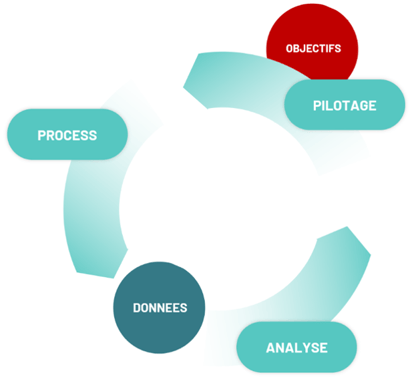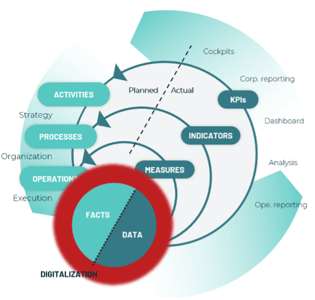By Charles Parat, Data Consulting Director
& Jean-Luc Salinas, Operations Director - Solution BI France
With this series of articles, you’ll come to understand why business intelligence is among companies’ greatest ambitions.
Not an expert in data science? No problem! We’ll do our best to explain in plain language how to effectively use data to improve your day-to-day performance.
BUSINESS INTELLIGENCE IN 3 STEPS
TO BETTER UNDERSTAND WHY WE NEED IT
The massive and growing flood of data produced by businesses is a gold mine of information for understanding at any given moment the state of progress on plans and how close teams are to achieving objectives, as well as the amount of resources used to get there.
In short, all the information needed to lead a company!
These data are the fuel of “business intelligence,” a branch of information science that allows each business stakeholder to understand where they’re at and take the “best course of action.”
With this series of articles, we hope that each decision-maker will be able to better understand how essential it is to have several different types of expertise contributing to the lasting improvement of business performance, helping organizations get the most out of a “data and performance roadmap.”
However, to grasp the essentials, you have to understand the basics of BI, what it’s used for, and how it fits into the long-term planning of a company’s performance.
Step 1: Consider data through the lens of the company’s business processes
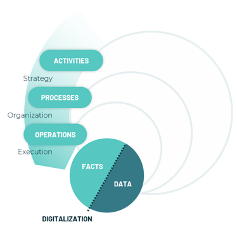
It all starts with your customers’ visions.
Each customer has a strategic vision for their essential activities: sales, design, manufacturing, purchase for resale, transportation, etc.
These activities break down into processes organized across the company’s various departments.
On an operational level, the various people involved go about executing operations that generate information and events, i.e. data, that shed light on that execution.
With the advent and exponential acceleration of business process digitalization, massive amounts of data are generated by the execution of these processes.
While originally humans were responsible for most data generation, they are increasingly being replaced or assisted by automated processes.
The current trend is toward the Internet of Things (IoT), robotic processing automation (RPA), and other such technologies, inundating us with data.
Step 2: Transform data into information
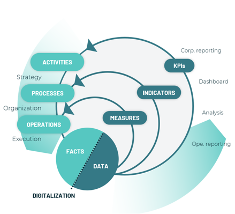
Provided that the data actually illustrate what you want to track and measure, your treasure trove of digital data can be used for an incredibly rich panel of analyses.
This ranges from the simple tracking of execution for the purposes of reporting to highly strategic indicators and documents observed by all levels of management, the board of directors, and supervisory authorities.
This production of information involves a whole host of analytical and predictive procedures intended to provide business lines with greater value extracted from the available data.
The most basic data can be used as raw operational information; data can be enriched to produce increasingly relevant information about performance on key indicators; and you can strive to make your data set as big, complete, and reliable as possible to be able to make predictions using artificial intelligence.
Step 3: Compare measured values with target values to manage all levels of a business
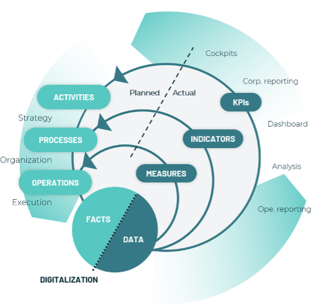
Operational, tactical, and strategic: with the ability to measure progress on these three levels of tracking, a company gets a full spectrum of applications allowing them to compare the values established in plans and budgets with the values actually captured in practice.
This tracking of forecasts allows you to measure performance and adjust the amount of resources dedicated to your ambitions.
These are techniques of enterprise performance management (EPM).
EPM covers every department of a company: sales, procurement, production, logistics, HR, and finance, up to the organization’s highest level of management.
Purpose 1: Cultivate your data assets
This model would be perfect if data were always exactly aligned with expectations, in terms of both quality and quantity. However, the data that flood into your systems don’t necessarily correspond to your intended analytical usage.
As such, you need to organize the correspondence between raw data and their usage, whether current or potential.
The purpose is to enable each user to understand the possible uses, as well as to take inspiration to come up with new uses and new sources of data.
The company should make available to as many people as possible the tools and organizational means to enable this progress while guaranteeing both top-notch knowledge-sharing and security appropriately adapted to the potential risks.
The company must organize constant collaboration between business-line teams and the IT team: this means establishing a new form of governance and allocating resources to match the ambitions.
The company must offer its “data as a service” for all possible needs and uses. In other words, it needs a harmonious blend of appropriate techniques and organization.
Purpose 2: Initiate a virtuous cycle of continuous improvement

On top of that, the company must ensure that its new, effective organization will go beyond the original project sponsors and stakeholders.
It must be able to adapt to inevitable changes, including leadership change in crucial governance structures. Additionally, the organization must help mindsets and systems evolve, adapt to technological progress, respond to changes in the internal and external business environment, and even rethink the way things are done by adopting successive transformation plans.
When a company undertakes a data project, it must understand the importance of constantly maintaining it to continuously generate more value from it for its business lines.
The company must build, maintain, and execute a transformation roadmap relying on data.
All this explains our positioning on the BI areas of expertise
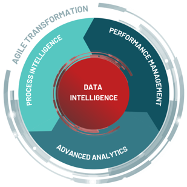
… which we believe are fundamental for delivering sustainable business intelligence to an organization:
• Process Intelligence
• Data intelligence
• Advanced Analytics
• Performance Management
• Agile Transformation
We will detail and illustrate these in the next articles in this series.
To be continued!
Suggested reading
Optimize Your Budget Cycles by Choosing Collaborative Business Intelligence


